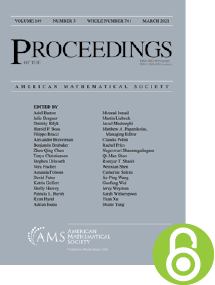On the left ideal in the universal enveloping algebra of a Lie group generated by a complex Lie subalgebra
HTML articles powered by AMS MathViewer
- by Juan Tirao PDF
- Proc. Amer. Math. Soc. 121 (1994), 1257-1266 Request permission
Abstract:
Let ${G_0}$ be a connected Lie group with Lie algebra ${g_0}$ and let h be a Lie subalgebra of the complexification g of ${g_0}$ . Let ${C^\infty }{({G_0})^h}$ be the annihilator of h in ${C^\infty }({G_0})$ and let $\mathcal {A} = \mathcal {A}({C^\infty }{({G_0})^h})$ be the annihilator of ${C^\infty }{({G_0})^h}$ in the universal enveloping algebra $\mathcal {U}(g)$ of g. If h is the complexification of the Lie algebra ${h_0}$ of a Lie subgroup ${H_0}$ of ${G_0}$ then $\mathcal {A} = \mathcal {U}(g)h$ whenever ${H_0}$ is closed, is a known result, and the point of this paper is to prove the converse assertion. The paper has two distinct parts, one for ${C^\infty }$, the other for holomorphic functions. In the first part the Lie algebra ${\bar h_0}$ of the closure of ${H_0}$ is characterized as the annihilator in ${g_0}$ of ${C^\infty }{({G_0})^h}$, and it is proved that ${h_0}$ is an ideal in ${\bar h_0}$ and that ${\bar h_0} = {h_0} \oplus v$ where v is an abelian subalgebra of ${\bar h_0}$. In the second part we consider a complexification G of ${G_0}$ and assume that h is the Lie algebra of a closed connected subgroup H of G. Then we establish that $\mathcal {A}(\mathcal {O}{(G)^h}) = \mathcal {U}(g)h$ if and only if $G/H$ has many holomorphic functions. This is the case if $G/H$ is a quasi-affine variety. From this we get that if H is a unipotent subgroup of G or if G and H are reductive groups then $\mathcal {A}({C^\infty }{({G_0})^h}) = \mathcal {U}(g)h$.References
- A. Białynicki-Birula, G. Hochschild, and G. D. Mostow, Extensions of representations of algebraic linear groups, Amer. J. Math. 85 (1963), 131–144. MR 155938, DOI 10.2307/2373191 C. Chevalley, Theory of Lie groups, Vol. 1, Princeton Univ. Press, Princeton, NJ, 1946.
- Jacques Dixmier, Algèbres enveloppantes, Cahiers Scientifiques, Fasc. XXXVII, Gauthier-Villars Éditeur, Paris-Brussels-Montreal, Que., 1974 (French). MR 0498737
- Morikuni Gotô, Faithful representations of Lie groups. I, Math. Japon. 1 (1948), 107–119. MR 29919
- Sigurđur Helgason, Differential geometry and symmetric spaces, Pure and Applied Mathematics, Vol. XII, Academic Press, New York-London, 1962. MR 0145455
- G. Hochschild and G. D. Mostow, Affine embeddings of complex analytic homogeneous spaces, Amer. J. Math. 87 (1965), 807–839. MR 191900, DOI 10.2307/2373247
- G. Hochschild and G. D. Mostow, Representations and representative functions of Lie groups, Ann. of Math. (2) 66 (1957), 495–542. MR 98796, DOI 10.2307/1969906
- James E. Humphreys, Linear algebraic groups, Graduate Texts in Mathematics, No. 21, Springer-Verlag, New York-Heidelberg, 1975. MR 0396773
- A. T. Huckleberry and E. Oeljeklaus, Homogeneous spaces from a complex analytic viewpoint, Manifolds and Lie groups (Notre Dame, Ind., 1980) Progr. Math., vol. 14, Birkhäuser, Boston, Mass., 1981, pp. 159–186. MR 642856
- George Daniel Mostow, The extensibility of local Lie groups of transformations and groups on surfaces, Ann. of Math. (2) 52 (1950), 606–636. MR 48464, DOI 10.2307/1969437
- Mitsuo Sugiura, The Tannaka duality theorem for semisimple Lie groups and the unitarian trick, Manifolds and Lie groups (Notre Dame, Ind., 1980) Progr. Math., vol. 14, Birkhäuser, Boston, Mass., 1981, pp. 405–428. MR 642870
- Garth Warner, Harmonic analysis on semi-simple Lie groups. I, Die Grundlehren der mathematischen Wissenschaften, Band 188, Springer-Verlag, New York-Heidelberg, 1972. MR 0498999
Additional Information
- © Copyright 1994 American Mathematical Society
- Journal: Proc. Amer. Math. Soc. 121 (1994), 1257-1266
- MSC: Primary 22E15; Secondary 17B35, 22E60
- DOI: https://doi.org/10.1090/S0002-9939-1994-1189550-8
- MathSciNet review: 1189550


